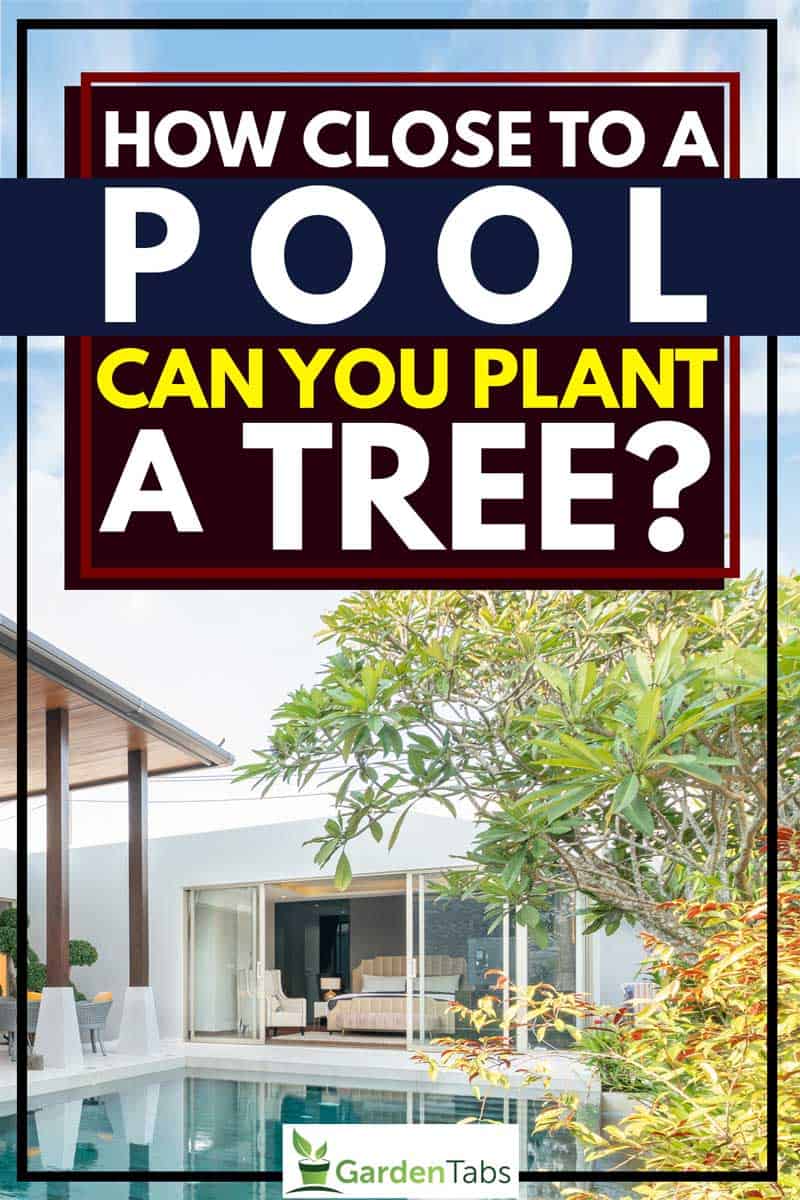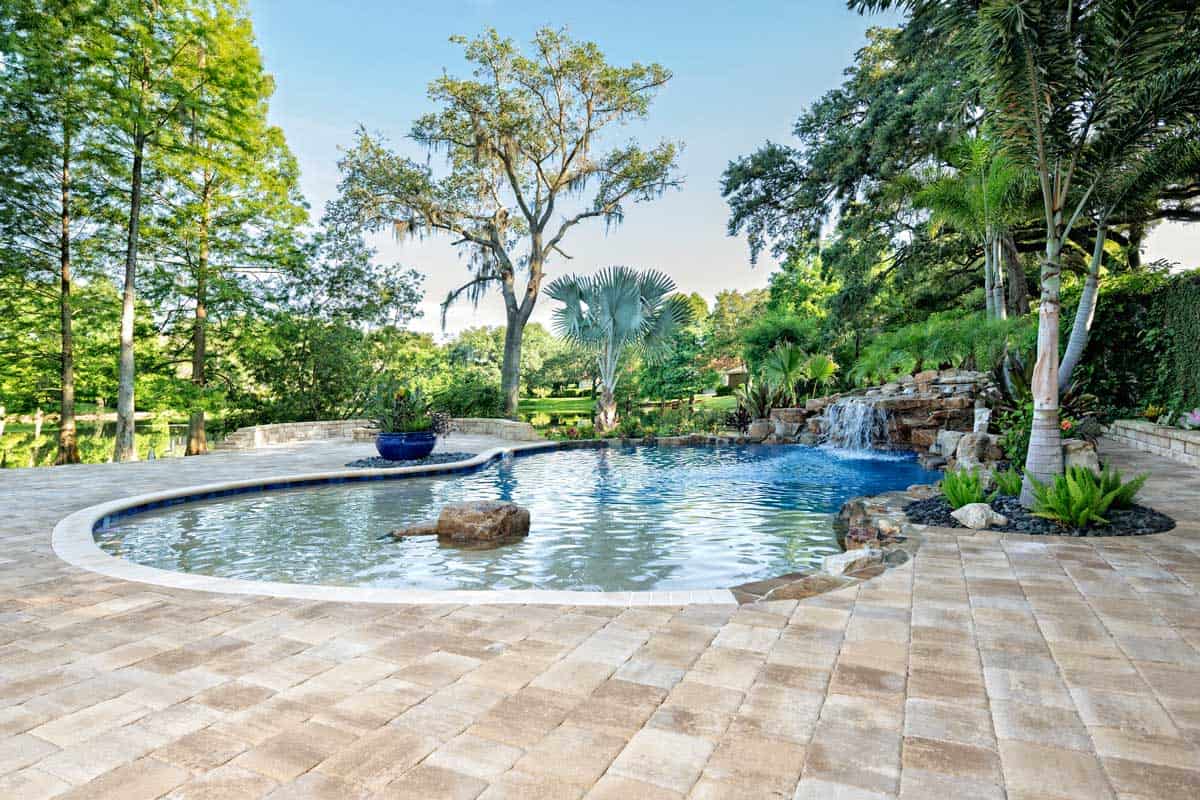 Maybe you already have a pool, but a new home has cropped up, and you want some privacy by planting a tree. Or you're building from scratch, and it's time to make landscaping decisions. Trees are beautiful, they provide shade and privacy, but sometimes they can create more work with a pool. So how close should you get to your pool when you plant a tree?
Maybe you already have a pool, but a new home has cropped up, and you want some privacy by planting a tree. Or you're building from scratch, and it's time to make landscaping decisions. Trees are beautiful, they provide shade and privacy, but sometimes they can create more work with a pool. So how close should you get to your pool when you plant a tree?How Close Can I Plant A Tree To My Pool?
If you want to plant a tree near your pool, you'll want to consider a few things. Is your pool gunite? Gunite pools are more resistant to root structure invasion and, therefore, you have more flexibility. A hardpack surrounds Vinyl-sided pools, but roots can work their way through.
When planting a tree next to your pool, remember that the canopy of the tree mirrors the size of the root structure. So a spreading oak or maple will have an equally extensive root structure. They also drop leaves, acorns, and seeds so they'll create more work poolside.
For trees with a minor spread of roots, such as evergreens, magnolia, and palms, the general guidance is to put the tree a minimum of five feet from the edge of the pool.
Can Tree Roots Damage A Pool?
They can, but it's more likely they will cause damage to your surrounding patio. Because most in-ground pools are gunite or fiberglass, the tree roots will grow and conform around the pool shell. However, the pavers and concrete you use for your patio may not be so fortunate. Bad actors that you don't want too near to your pool are: poplar, ash, alder, pine, oak, eucalyptus, willows, and elms.
What Are Good Trees To Plant Near A Pool?

There are a variety of factors to think about here beyond the root structure. The tops of trees can cause as many problems, or maintenance, for the pool owner as the worry of underground root damage can. Falling leaves, debris from seeds, nuts, fruit, can clog your filters, cause staining, and create a boatload of extra work.
Which begs the question, which trees are best? Here's a list of some of the best types of trees near your pool. Remember that each climate and planting zone may have the best version of this tree for that area.
- Acacia Trees
- Banana Trees
- Citrus Trees
- Evergreens
- Holly
- Magnolia
- Olive
- Oleander
- Windmill Palm
Pink banana trees add not only the beauty of their broad waxy leaves but a bright splash of delicious color in the fruit.
Click here to see this on Amazon.
The magnolia tree is an evergreen, and it does bloom lovely white flowers. You might want to plant this one slightly farther from your pool as it will drop leaves and will reach a circumference of 10-15' (and 20-25' high), but they are large and not hard to clean up.
Click here to see this on Amazon.
Olive trees are beautiful with their grey-green leaves. They grow to about 20' high and will not get much broader than 12' wide, but they produce delicious olives. They do drop leaves if temps drop below 20' but only once per year, so clean up is minimal. If you live in a warmer climate, you'll only be picking up delicious olives.
Click here to see this on Amazon.
Can You Plant A Palm Tree Next To A Pool?
You're California day dreamin', which means you must have a palm tree next to your pool. They seem to grow by the ocean in spades, and they're synonymous with Palm Springs, and Palm Springs is the pool capital of the States. But none of your neighbors have palm trees by their pool. Can you?
Yes, you can plant a palm tree by your pool. The queen palm reaches a great height of 15-20' so provides majesty as well as the look you're going for. Other palm varieties that will work are as follows:
- Sago Palm
- Queen Palm
- Windmill Palm
- Cane Palm
- Mediterranean Fan Palm
It's possible to start a queen palm from a small starter plant like this, but it will take, on average, 10-13 years to achieve its full height. That's fast as far as trees go, but if you want a larger tree, you may need to contact a landscaping company.
Click here on Amazon to see the starter plants.
Though not a true palm, the sago palm looks like one. The bulbous base and frothy outspreading fronds give a great look to your landscaping. They're slow-growing, so it may take several years to reach a maximum height of around 10 feet.
Click here to see this on Amazon.
The Mediterranean Fan Palm can grow anywhere from 6-20 feet tall when fully grown. This another cold-hardy variety so will work for more gardening zones than say, the queen palm. It likes full sun to moderate shade and is a relatively easy plant to care for.
Click here to see this on Amazon.
Windmill palms are available in cold-hardy varieties as well as warm weather varieties. They're low maintenance, pest resistant, and a perfect choice for the poolside.
Click here to see this on Amazon.
Can Pool Water Kill A Tree?

Now you've got an idea of which trees you may plant, but can all the splashing or overrun of your pool water cause plant death?
Just kids splashing around is not going to kill your trees. However, if you need to drain your pool for some reason, you need to be mindful of where that water goes. Pool water contains chemicals that, too much, too fast, can do damage and sometimes even kill your trees. So be sure and put it somewhere it won't harm.
Hopefully, now your landscaping plan is fully coagulating in your mind. You know which trees not to plant (those with falling leaves, fruits, and nuts that stain, flowers that litter and clog filters, or spreading root systems) and which to plant (those that aren't messy and have more compact root systems), and more importantly how far to plant them from the edge of the pool.
We have a few more posts here on Garden Tab that you may find interesting:








Informative article, thank you! We just removed an 18-year-old date palm planted 8’ from the pool. The lateral roots, which built layer upon layer, tunneled under the decking toward the pool. This essentially lifted the entire walkway, creating a 1” gap between the tile and coping. If the water level were high enough, it would then drain through that gap and back behind the pool’s shell. Personally, I’ll never plant a palm next to my pool again. If and when planting near a pool, I strongly recommend inspecting irrigation intermittently to ensure roots don’t go on the hunt for it elsewhere, i.e. toward your pool.